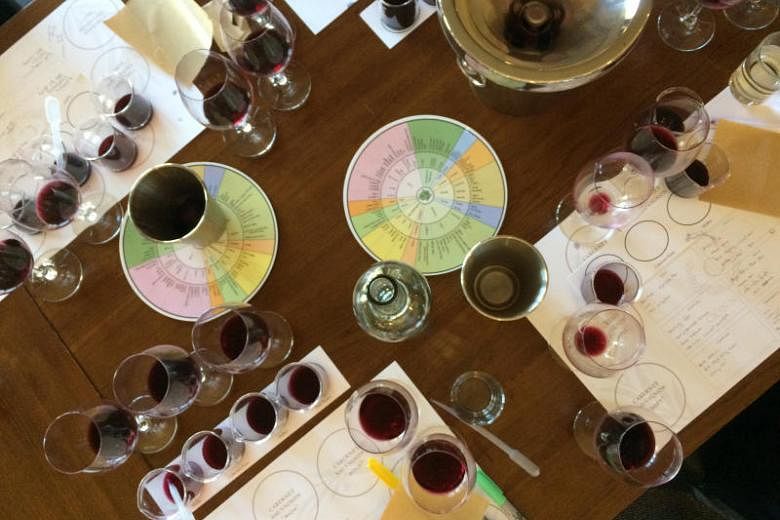(WASHINGTON POST) - Sitting in a room full of wine barrels, winemakers and sommeliers seemed like a dream come true until such terms as "sub-appellations," "malolactic fermentation" and "diurnal fluctuation" started being bandied about with abandon.
It was like I had landed on an island where the natives speak a different language and I was just hoping to nod my head at the correct time.
I am a wine consumer, not a connoisseur, although I have a pretty good palate that I am trying to hone, which is why I was drawn to this wine-blending class in the heart of California's Napa Valley.
I imagined sampling different varietals - cabernet, zinfandel, syrah - and blending them to find my personal flavour profile, much in the way I might adjust a cake recipe by adding a teaspoon of smoked cinnamon or a touch of fresh orange zest. And once I got over being intimidated by the winemaker's lexicon, that is exactly what happened. In fact, now I'm a bit of a wine-blending junkie.
That, of course, is Conn Creek Winery's goal. "Our hope is that our guests enjoy the diversity of the wines and understand what makes them the way they are, ideally triggering a greater interest in the complexities of wine," says winemaker Mike McGrath, who teaches the class. "Typically, we see guests gravitate towards the rich and bold section, but once they start blending, each creation becomes unique."
The first task was to create a 600ml cabernet sauvignon base, using California wines whose flavours were categorised as either soft, supple, complex, rich or bold, in any combination, tasting each variety for different flavours.
For me, the "soft" cabernet held notes of vanilla, while I found the "supple" variety to have a slightly yeasty base that reminded me of proofing sweet rolls. "Bold" held the scent of late summer roses and almost overripe berries. My palate gravitated towards wines from central Napa Valley's Rutherford AVA (American Viticultural Area), said to have a "dusty" quality from sandy soil and volcanic deposits, and the Calistoga AVA, closer to the Russian River, where hot days and cool nights provide rich flavours and bright acidity.
It is chemistry, for sure, but utterly subjective at the same time.
After two tests, I came up with a base blend of 300ml "supple," 200ml "bold" and 100ml "complex" - a combination that was just a bit buttery with a savoury floral undertone, like a not-too-sweet blackberry danish. Once that base was created, it was time to add a total of 200ml of other varietals - merlot, cabernet franc, malbec or petit verdot - for an even more personal twist, rather like adding fresh herbs, citrus or spice to a bowl of pasta.
I found that 150ml of merlot provided a mild peppery bite and 50ml of a tannic petit verdot balanced out all the fruit with a touch of dryness. In about an hour, I had my very own bottle of wine, which would be ready to drink after three months of resting in the bottle. And, surprisingly, I did feel a bit like a winemaker, with an improved vocabulary to match. It made me want to figure out how I could blend wine on my own turf.
Enter Blendtique, the brainchild of California winemaker Billy Dim, who will send you a box filled with all the tools to blend wine in the comfort of your own home, from the measuring pipette to four single-varietal wines that you can mix and match to your heart's content.
"We wanted to demystify the winemaking experience," says Mr Dim, "and for people to feel comfortable. There are no right or wrong answers. If you like the result, then you've won."
The provided wines - syrah, Grenache, cabernet and merlot from California's central coast - are all meant to be approachable and less intimidating to average consumers. "The product we like to put in our kits are great to drink on their own," says Mr Dim. "The fun is in how much the wine can change by putting in 10 or 15 or 20 per cent of a different variety."
A kit, of course, is not the only way to go. Because red wine grapes are typically blended more often than white, sommelier Sarah Young, who runs the wine-blending class at the Grand Bohemian Hotel in Charleston, South Carolina, suggests picking up four or five single-varietal reds - such as cabernet, petite syrah, malbec, merlot, cabernet franc and petit verdot - for a home-grown blending experiment. A measuring cup and a set of wine glasses are the only equipment you need, plus maybe a plate of plain crackers to cleanse the palate between sips.
"With hundreds of possible blends that can be created, the options are endless," says Ms Young.
That has been my takeaway. While my previous notions of "wine blending" were limited to topping off my glass from a different bottle, I have now a better idea of the flavours to be found in varietals from far-flung locations and how my taste buds might react.
Whether I am mixing and matching at home or reading labels more carefully at the store, I have started to discover my inner sommelier.

